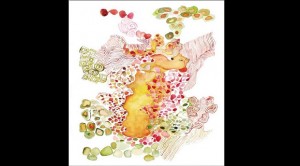
The year of my birth, 1930, is a horse year in the Chinese horoscope. This year it is that of the Wood Horse, which is predicted to be “expansive and exuberant; it rewards honest opinions and disciplined thinking. People will be more forgiving and cooperative.
“In teamwork, the Wood Year brings out the best in everyone. It will be easier to craft common-sense solutions and have fun in the process. It is a fabulous year for travel, parties and community events.”
Horse Year friends and I see many similarities between our zodiac animal and us. We work hard (“like a horse!”), can bear heavy loads, can run a race and win it, and we kick when provoked. Horses fantasize growing a horn on their foreheads and becoming unique.
The sign of the pig, however, is the most appreciated in its dead state—as lechon. Other food animals are the cat (in siopao during the Japanese Occupation), the dog (pulutan), the ox (kare-kare), the sheep or its lamb (roasted or broiled) or the goat (caldereta), the monkey (monkey brains for seriously sadistic gourmets). The losing rooster in a cockfight is in the talunang manok soup. In its female form the bird is simply (Max) chicken.
The most dangerous animal to eat is the snake because it was used as a disguise by Satan and contains venom. But the Chinese, being Buddhists, have no fear of eating snakes, and there are many popular snake dishes in Hong Kong. The snake’s friendlier form is the dragon, star of kung fu movies.
The rat is a rat forever and is inedible. But most Filipinos consider it intelligent. It understands when you talk ill about it, and will get back at you by chewing your favorite shirt into rags. Hence, the rat is often referred to as “ang mabait.”
Smart pets
Many people have smart pet animals. My balae, Josie, owned a Japanese Spitz who could sing. Spy (so named because he had one black eye) was about to be given away because he had so many fleas. But someone put Tchaikovsky’s “1812 Overture” on the turntable, and Spy began to sing.
The family was impressed with Spy’s talent. Whenever there were visitors, Josie would put the dog on the sofa and Spy would entertain the guests. So she stopped giving the dog away. Before Spy died, he was even able to teach their other dog, a poodle, to sing.
My experience with pets is very limited. Aside from my only cat and our series of forgettable askal, I recall having housed a pigeon (or dove). In the 1970s it was fashionable for wedding receptions to have a split bamboo bell covered with flowers from where was released two white doves.
My mother was an incorrigible catcher of wedding bell doves. Whenever she jumped for one, even in high heels, she always got it. She brought home so many wedding bell doves and even forced one on me. My husband clipped its wings and we named her Tessie.
The bird adored him and followed my husband, pigeon-toed, all over the house including the bathroom. She would watch him shave, comb his hair and put on deodorant. When it was time to shower, though, he would shoo Tessie out by splashing water relentlessly on her and then he would bang the door and lock it.
Twentieth century Austrian philosopher and clairvoyant Rudolf Steiner professed that creatures of the universe, eons ago, used to help one another. When man came into being he was supposed to have all the characteristics of the animal kingdom.
But the beasts volunteered to take on these traits and so it is they who growl and claw and kill other beings. To the lowest on the earth’s totem pole, therefore, we owe a debt of gratitude.
As we have all observed, though, vestiges of savage behavior remain, only now they are well in control under that coat and tie or barong. Once in a while, these primal urges break loose and we read about savage beatings or insane and brutal killings of one human by another. The old folks used to comment on such behavior with the Spanish “Animal!”
The occasional snarl that accompanies a human’s sarcastic remark or the undisguised craving of a gourmand for a still bloody steak may well be vestiges of it.
Thank God for the generosity of animals.

